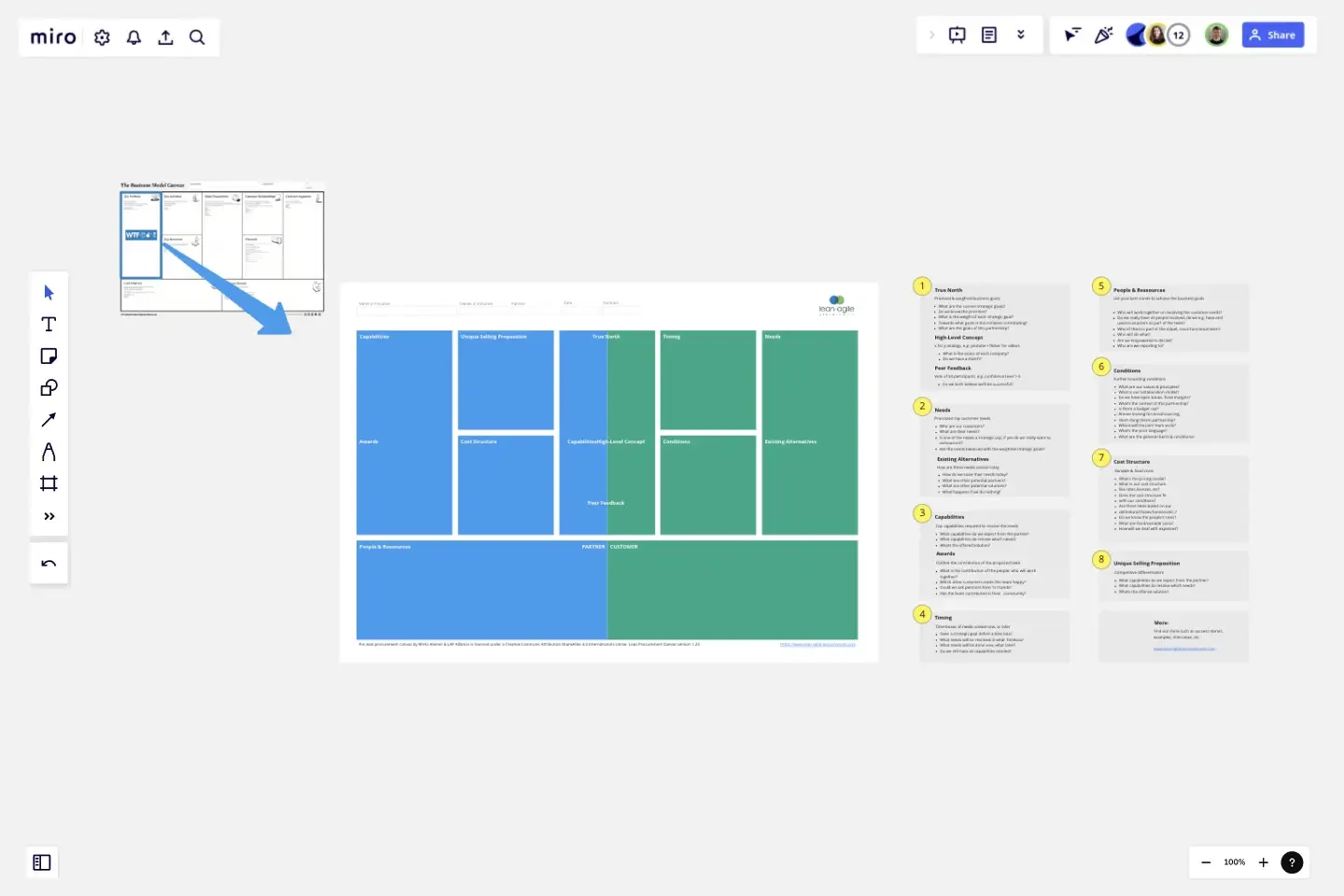Lean Procurement Canvas
With the Lean Procurement Canvas and Lean-Agile Procurement we provide for the very first time a tool and approach that respects agile values and practices during sourcing and/or sales.
For successfully going to market with a new business case, a strong team consisting of internal and/or external people is the foundation. However finding the right complementary people, partners, services or products isn’t easy and takes time. Current sourcing processes and approaches can’t cope with uncertainty and complexity of innovation, new strategic partners, etc.
When should you use the Lean Procurement Canvas?
With the Lean Procurement Canvas and Lean-Agile Procurement we provide for the very first time a tool and approach that respects agile values and practices during sourcing and/or sales. This leads to improved lead times of days/weeks instead of months (from idea to first value delivered), minimizes risk and maximizes business value!
Who is the Lean Procurement Canvas for?
The Canvas can be used by startups, corporations who would like to:
Setup and align a new internal, mixed or outsourced 3rd party agile product delivery team
Co-create an agile agreement with multiple vendors in the same room simultaneously
Assess and manage existing teams or partnerships with 3rd parties
Close a deal more effectively as a vendor
It has been used by Air France KLM, Gazprom, BNP Parisbas, Auckland Council and many more from the private and public sector.
Get started with this template right now.
Sprint Planning with Jira Template
Works best for:
Sprint Planning, Agile
The Sprint Planning with Jira template in Miro is a powerful tool designed to streamline and enhance your sprint planning sessions. One of the key benefits of this template is its Jira integration, which saves time and effort when planning and aligning teams. By integrating directly with Jira, the template allows for seamless import and management of tasks, ensuring that all your Jira tickets are up-to-date and easily accessible within Miro. This reduces the need for manual updates and minimizes errors, making the planning process more efficient and effective.
Agile Retrospective
Works best for:
Retrosprective, Agile Methodology, Meetings
The Agile Retrospective template offers a dynamic and adaptive framework for teams practicing agile methodologies. It provides elements for reflecting on sprint performance, identifying bottlenecks, and planning improvements. This template enables teams to adapt and refine their processes continuously, fostering a culture of learning and innovation. By promoting agility and adaptability, the Agile Retrospective empowers teams to optimize their workflows, drive continuous improvement, and deliver value to their stakeholders effectively.
Scrum Puzzle
Works best for:
Agile
The Scrum Puzzle is a collaborative activity that reinforces Scrum roles, artifacts, and ceremonies. By assembling a puzzle representing the Scrum framework, teams gain a deeper understanding of its components and how they interrelate. This template offers a fun and interactive way to reinforce Scrum knowledge and promote team alignment, empowering practitioners to apply Scrum principles effectively and deliver value with agility.
Burndown Chart Template
Works best for:
Project Management, Agile Workflows, Mapping
Whoa whoa whoa, pace yourself! That means knowing how much work is left—and, based on the delivery date, how much time you’ll have for each task. Perfect for project managers, Burndown Charts create a clear visualization of a team’s remaining work to help get it done on time and on budget. These charts have other big benefits, too. They encourage transparency and help individual team members be aware of their work pace so they can adjust or maintain it.
Start, Stop, Continue Template
Works best for:
Retrospectives, Meetings, Workshops
Giving and receiving feedback can be challenging and intimidating. It’s hard to look back over a quarter or even a week and parse a set of decisions into “positive” and “negative.” The Start Stop Continue framework was created to make it easier to reflect on your team’s recent experiences. The Start Stop Continue template encourages teams to look at specific actions they should start doing, stop doing, and continue doing. Together, collaborators agree on the most important steps to be more productive and successful.
8 Different Ways to Organize Your Backlog
Works best for:
Agile
Explore 8 different techniques for managing and prioritizing work effectively with this template. From prioritization matrices to story mapping, it offers a comprehensive overview of backlog management strategies. By understanding the strengths and limitations of each approach, teams can tailor their backlog organization to optimize workflow, empowering teams to stay organized and focused on delivering value.
